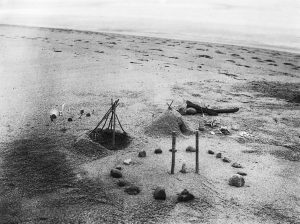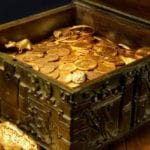 Technology
Technology  Technology
Technology  Movies and TV
Movies and TV 10 Fictional Plagues We’re Glad Aren’t Real
 Weird Stuff
Weird Stuff 10 Mind-Blowing Incidents and Strange Finds in the Drive-Thru
 Miscellaneous
Miscellaneous 10 Famous People You Didn’t Know Killed Someone
 Crime
Crime !0 American Politicians Who Have Served Time in Prison
 Books
Books 10 Stories Far Ahead of Their Time
 Politics
Politics 10 Surprising Expectations of U.S. Presidents after Leaving Office
 Humans
Humans Real-Life Marvels: 10 People with Incredible Abilities
 Movies and TV
Movies and TV 10 Actors Who Tried and Failed at Directing
 History
History 10 Stunning Events Caught on Film or Tape Before Cell Phones
 Technology
Technology 10 Crazy AI Controversies… So Far
 Movies and TV
Movies and TV 10 Fictional Plagues We’re Glad Aren’t Real
 Weird Stuff
Weird Stuff 10 Mind-Blowing Incidents and Strange Finds in the Drive-Thru
Who's Behind Listverse?

Jamie Frater
Head Editor
Jamie founded Listverse due to an insatiable desire to share fascinating, obscure, and bizarre facts. He has been a guest speaker on numerous national radio and television stations and is a five time published author.
More About Us Miscellaneous
Miscellaneous 10 Famous People You Didn’t Know Killed Someone
 Crime
Crime !0 American Politicians Who Have Served Time in Prison
 Books
Books 10 Stories Far Ahead of Their Time
 Politics
Politics 10 Surprising Expectations of U.S. Presidents after Leaving Office
 Humans
Humans Real-Life Marvels: 10 People with Incredible Abilities
 Movies and TV
Movies and TV 10 Actors Who Tried and Failed at Directing
 History
History 10 Stunning Events Caught on Film or Tape Before Cell Phones
10 Revealing Recreations of Long-Gone Things
Ancient recreations remain one of the most captivating corners of science. It gives people a way to directly experience and interact with history. We can smell, see, and touch things that are long gone. But some recreations also reveal unknown facts or settle sticky debates. From taste-testing Neanderthal pancakes to finally understanding a deadly sugar tsunami, here are ten of the most fascinating recreations of recent times.
Related: 10 Times We Recreated Ancient History With Science
10 Toxic Water Bottles

Not all recreations are whimsical experiments. Sometimes, when scientists copy ancient technology, they do so out of real concern. In this case, researchers wondered if the bitumen used by ancient Californian Indians to seal water bottles had a negative impact on their health. Bitumen is a byproduct of petroleum that’s packed with polycyclic aromatic hydrocarbons (PAHs), a carcinogenic that can also damage organs and impair development.
During the test, the team created two different types of water bottles with traditional methods. One was lined with soft bitumen (which washes ashore) and the other with hard bitumen, more commonly found in land deposits.
Surprisingly, the containers didn’t leach dangerous amounts of PAHs into the water even after several weeks. However, the scientists discovered that the manufacturing process of the bottles would have exposed the ancient craftsmen to hazardous levels of PAHs in the air. Fatty substances in the bottles also quickly became contaminated with PAHs.
Ancient remains of Native Californians indicated that the overall health of their population declined over time. This experiment was the first to suggest that bitumen might’ve pushed them down that slippery slope, as they also used the tarry substance to make smoke signals and fix arrowheads to shafts. Both activities would’ve exposed them to even more PAHs.[1]
9 The Drinking Game of Kottabos
Drinking games are not a modern invention. Indeed, the ancient Greeks were getting sloshed playing something called kottabos. The goal was to use drinking cups to flick the last dregs of your wine at a target in order to win a prize.
But merely explaining a game that hasn’t been played in 2,000 years wasn’t enough for one professor at the West Chester University of Pennsylvania. Heather Sharpe decided to bring kottabos back to life, but instead of elite Greeks getting tipsy, it would be her students.
Sharpe 3D-printed several traditional drinking cups called kylixes, filled them with grape juice, and roped in a couple of volunteers. Based on ancient works of art depicting kottabos, it appeared that a forehand throw (similar to tossing a Frisbee) was the best way to hit the targets. However, that oddly turned out to not be the case. Sharpe’s team discovered that an overhand toss (like pitching a baseball) delivered the most hits instead.
The students weren’t allowed to become drunk, but the ancient Greeks would’ve become increasingly inebriated. They could only fling wine left at the bottom of their cups, which meant that they had to drink several kylixes to get multiple throws. Sharpe suspects that as their aim worsened, the more chaotic the throwing became. A game of kottabos probably ended with wine-drenched players and a messy room.[2]
8 Cleopatra’s Perfume
After discovering an ancient perfume factory in Egypt, archaeologists made a perfume that was likely worn by Cleopatra. During her rule (51–30 BC), the Egyptian elite was fond of a product called Mendesian perfume. It was named after the city where it was made—Mendes—and that’s where the factory was unearthed.
The scientists experimented with different variables based on residues found at the site. It also helped that they had the general recipe for the famous scent, which was preserved in both ancient Roman and Greek texts.
In 2019, Mendesian perfume once again saw the light of day. Just some of the ingredients included cinnamon, pine resin, and date oil. So, what did it smell like? Reportedly, the perfume had a strong, spicy scent with subtle notes of mustiness and sweetness. Once applied, it also lingered much longer than modern fragrances.
One cannot say with certainty that Cleopatra wore this scent, but given the popularity of Mendesian eau de toilette at the time and her love of perfumes, she probably did.[3]
7 The Tasmanian Tiger’s Brain
The last thylacine, or Tasmanian Tiger, died in 1936. During the species’ lifetime, almost no information about their natural behaviors was gathered, and as a result, we know very little of how these marsupial carnivores behaved. But researchers had a good starting point: a collection of old eyewitness stories from those who had seen the animals alive.
In 2017, scientists studied and scanned two thylacine brains that were preserved almost a century ago. This allowed them to create a digital 3D brain complete with neural networks. A prominent theme of anecdotal stories stated that the Tasmanian tiger was a crafty hunter that carefully planned out its kills. If this was true, then their brains would show some sort of evidence in that regard—and scientists found it.
When they looked at the caudate regions, which support complex thinking, it became clear that the thylacine brain dedicated more space to these areas than Tasmanian Devils, the reigning apex predator on Tasmania today. This supported the stories that thylacines were calculating, smart animals. The discovery also aligns with what we know of Devil behavior, that they prefer opportunistic scavenging to hunting.[4]
6 A Pit That Fed 200 People

Recently, archaeologists found a 9,000-year-old barbecue pit in Cyprus, but there was a problem. Such “earth ovens” cannot be too big; otherwise, they struggle to retain enough heat to cook meat. The Cyprus pit was enormous, measuring 8 feet (2.5 meters) across and 3 feet (1 meter) deep. This cast doubt on the well-like structure’s ability to function properly.
In 2015, staying as true as they could to Stone Age building techniques and materials, the researchers built their own pit. After they dug down to the same depth, they sealed it with the same kind of stones and clay. The team even made their own charcoals from carob and lemon wood and tanned goat skins to wrap the meat. They also chose traditional fare—a whole pig and a goat divided into parcels weighing 150 pounds (70 kilograms) and 80 pounds (38 kilograms), respectively.
Remarkably, when it became time to taste the meat (after cooking roughly for a day), the researchers were able to feed almost 200 volunteers, and there were enough leftovers for a week. Not only did the pit work extra well, but it also produced a surprisingly delicious fare, as the carob and lemon wood had infused their flavor into the meat.[5]
5 A Surprisingly Good Medieval Potion
Are you a medieval person with an infected eye? Smear some “Bald’s eyesalve” on the affected blinker, and literally watch the amazing results! But seriously, reading the ingredients today, one might be forgiven for thinking that the potion could only make things worse. Why? It was made of wine, onion, garlic, and cow bile.
However, that didn’t put scientists off. Sure, the recipe was over a thousand years old, but what piqued the interest of microbiologists was the fact that every ingredient had some antibacterial properties. So they whipped up several batches and applied them to different colonies of bacteria.
The ancient remedy worked. In fact, its effectiveness against tough strains of bacteria was mind-blowing. Some of the colonies had a barrier-like biofilm that made them hard to kill. Among them was an “ultimate” biofilm that makes diabetic foot ulcers almost impossible to treat, often leading to amputation. Remarkably, the eye potion was effective against five such variations linked to diabetic ulcers, and it also killed bacteria that cause staph infections—even those resistant to antibiotics.[6]
4 Bronze Age Duels in the Lab
In 2020, an old debate in archaeology finally boiled over, and people came to blows. Luckily, this wasn’t a workplace assault situation. Those involved agreed to participate in duels with bronze swords to settle a nagging question—were these weapons really used on ancient battlefields, seeing that they aren’t the strongest of blades?
For the experiment, swords were made using traditional techniques from the middle to late Bronze Age. They were given to weapon experts to battle each other with real combat methods before the marks on the blades were then compared to those found on 110 ancient swords. They were a match. This strongly suggested that Bronze Age warriors didn’t carry such items for ceremonial reasons. Instead, these weapons were wielded by skilled swordsmen during real fights.[7]
3 Neanderthal Pancakes Are Nutty
For a long time, people thought that Neanderthals were dumb. But today, we know that they had sophisticated tools for hunting and domestic use. There’s strong evidence that Neanderthals created art and jewelry. They painted with different colors. They had graveyards.
Even though the image of Neanderthals is becoming clearer, it wasn’t until recently that researchers realized that this group of hominids also had a complex culinary culture. This happened after 70,000-year-old charred food remnants were collected at Shanidar Cave in Iraq, where Neanderthals lived for a long time. It revealed that their prehistoric cooking skills were unexpectedly complex and involved a variety of ingredients and preparation techniques.
When researchers recreated a recipe, using what they’d learned about Neanderthal food preparation and also selecting seeds still growing near the cave, they created something that looked a lot like a pancake or flatbread. A quick nibble revealed that it was tasty. The flavor was described as “nutty.”[8]
2 T-Rex’s Breath (It’s Bad)
Many T-Rex fans wonder what their favorite prehistoric predator really looked like. How did it truly behave? But even the most hard-core admirers rarely wonder what the Cretaceous beast’s breath smelled like. It did occur, however, to someone at Chicago’s Field Museum. In 2019, the public was able to experience this unusual recreation after the museum added interactive sensory details to its SUE exhibit.
SUE is the most complete T-Rex fossil in existence. Visitors could touch recreated dinosaur skin and listen to what the fearsome creature sounded like. But the smells stole the show. One of them was SUE’s prehistoric environment. Based on the time she was alive and the location where the dinosaur’s remains were found, experts created “ancient air” that included whiffs of cypress resin, tulip trees, ginger, and pond water.
SUE’s full-strength breath, however, would have made visitors sick. The researchers had to dilute what was essentially the smell of rotting meat. True enough, the anatomy of T-Rex’s teeth suggested that after eating, bits of flesh would’ve gotten stuck between the animal’s teeth. As time passed, the meat would’ve putrefied in her mouth, giving SUE’s breath a dreadful punch.[9]
1 Boston’s Molasses Tsunami
In January 1919, a bizarre event unfolded in Boston’s North End neighborhood. A container broke and spilled over 2.3 million gallons (8.7 million liters) of molasses. The liquid crashed into the streets as a 25-foot (7.6-meter) wave that raced along at 35 miles per hour (56 kph), causing war-like damage to buildings. People also got swept away, and around 21 perished.
The tragedy left questions that couldn’t be answered for a long time. Was it even possible for molasses to reach such a lethal speed—or did the history books get it wrong? And why did so many people die?
In 2016, Harvard University students recreated the event. Since it wasn’t a good idea to puncture a molasses tank in a suburb, they built a scale model and chose corn syrup as a suitable alternative.
The experiment unveiled several clues and answers. It showed that warm corn syrup had no problem flooding the “buildings” with great speed. Under cold conditions (the weather was chilly on that fateful day), the sugary substance quickly hardened and most likely trapped the victims, causing their demise either through asphyxiation or making it too dangerous for others to attempt a rescue.[10]








